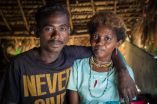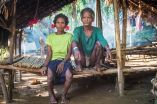Why modern hunter-gatherers live with so few kin
2015-05-14
(Press-News.org) This news release is available in Japanese.
Allowing both males and females in hunter-gatherer groups to choose their living companions reduces the number of family members in individual hunter-gatherer camps, a new study shows. The results answer a longstanding mystery about why hunter-gatherer populations have evolved to comprise large numbers of unrelated individuals, especially since hunter-gatherers have shown a strong preference to live with kin. Previously, studies have pointed to pair-bonding, or lifelong monogamous relationships in which couples go off and leave family behind, as one possible driver of hunter-gatherer groups made up of few related individuals. Here, to better understand how hunter-gatherers came to reside in this way, M. Dyble and colleagues developed a model of their behavior - running two versions of it, one where both the husband and wife in a hunter-gatherer couple could have equal influence over where their household would reside, and another where only one sex had influence. The researchers found that when both men and women had say over their living situation, with both husband and wife striving to maximize numbers of kin in their camp, communities were much less closely related than when only men or only women could choose. (Data from two contemporary hunter-gatherer societies in Africa and the Philippines matched the model closely.) Sexual equality seems to reduce relatedness of the people in a camp at any one time, the researchers say, but, critically, it increases the number of camps where an individual has one or more kin living, paving the way for cooperation and information exchange among groups without the need for more complex drivers, like wealth or war. The work represents an important contribution to our current understanding of human social and behavioral evolution.
INFORMATION:
Article #11: "Sex equality can explain the unique social structure of hunter-gatherer bands," by M. Dyble; G.D. Salali; N. Chaudhary; A. Page; D. Smith; J. Thompson; L. Vinicius; R. Mace; A.B. Migliano at University College London (UCL) in London, UK.
ELSE PRESS RELEASES FROM THIS DATE:
2015-05-14
This news release is available in Japanese. There's more than one explanation for how colony-living animals like bees evolve their unique social structure, according to a detailed genome analysis conducted by Karen Kapheim and colleagues. Bees are eusocial, meaning that some of their workers forego reproduction to care for their siblings. In some cases, this can lead to an elaborate and sophisticated "superorganism" of thousands of individuals. Kapheim and colleagues took a detailed look at the genomes of ten bee species to determine if the evolution of eusociality always ...
2015-05-14
New in the Hastings Center Report
Patient-satisfaction surveys: improving health care, or leading it astray? The downside of courage, right-to-try laws, and more in the May-June 2015 issue.
Patient-Satisfaction Surveys on a Scale of 0 to 10: Improving Health Care, or Leading It Astray?
Alexandra Junewicz and Stuart J. Youngner
It is increasingly common for patient-satisfaction surveys to be used as indicators of health care quality, as well as to influence the reimbursement paid to providers. But the authors argue that the surveys could eventually compromise the ...
2015-05-14
Many television advertisers voice fears that distracted viewers -- those increasingly frenetic multitaskers using smartphones, laptops and tablets while viewing TV - are becoming less receptive to advertisers' messages. A new study published in the online Articles in Advance section of Marketing Science, a journal of the Institute for Operations Research and the Management Sciences (INFORMS), refutes this conventional wisdom and concludes that the "second screen" puts a virtual store in every consumer's pocket. Multitasking viewers now visit, browse, and even buy advertised ...
2015-05-14
An anti-poverty program tested extensively on three continents has produced sustained gains in individuals' income, wealth, and well-being, according to a study published today in the journal Science.
The program provides very poor people with productive assets, such as livestock, as well as job training, life-skills coaching, and health information. Known as the "Graduation" program, its intention was to examine whether helping the poor in multiple ways simultaneously could be especially effective in fighting poverty.
Overall, with more than 20,000 people enrolled ...
2015-05-14
A new paper, co-authored by Woods Hole Research Center Senior Scientist Richard A. Houghton, entitled, "Audit of the global carbon budget: estimate errors and their impact on uptake uncertainty", was published in the journal Biogeosciences. The paper confirms that as carbon emissions continue to climb, so too has the Earth's capacity to absorb carbon dioxide from the atmosphere. About half of the emissions of CO2 each year remain in the atmosphere; the other half is taken up by the ecosystems on land and the oceans.
For Dr. Houghton, "There is no question that land ...
2015-05-14
A new work based on 3-D supercomputer simulations of earthquake data has found hidden rock structures deep under East Asia. Researchers from China, Canada, and the U.S. worked together to publish their results in March 2015 in the American Geophysical Union Journal of Geophysical Research, Solid Earth.
The scientists used seismic data from 227 East Asia earthquakes during 2007-2011, which they used to image depths to about 900 kilometers, or about 560 miles below ground.
Notable structures include a high velocity colossus beneath the Tibetan plateau, and a deep mantle ...
2015-05-14
GAINESVILLE, Fla. -- Raising awareness of the dangers of mouth and throat cancer increased the number of black men in some of Florida's poorest counties who sought screening for the first time, opening the door to improved survival rates through early detection and treatment, UF Health researchers report.
Black men have the lowest survival rates of mouth and throat cancer in the United States, and these rates have decreased even more in recent years. To combat this problem, UF Health researchers launched a five-month media campaign targeted at black men in some of Florida's ...
2015-05-14
A new study led by investigators at Brigham and Women's Hospital (BWH) reports the discovery of a genetic variant that is associated with a patient's likelihood of responding to interferon-beta, one of the medications used in treating multiple sclerosis (MS). Published in the Annals of Neurology on May 14, the study also presents evidence that the affected gene, SLC9A9, may have a broader role in regulating the development and activity of certain immune cells that play important roles in inflammatory diseases like MS.
A proportion of MS patients experience disease activity ...
2015-05-14
May 14, 2015 -- Researchers at Columbia University's Mailman School of Public Health and Leiden University in the Netherlands found that children whose mothers were malnourished at famine levels during the first 10 weeks of pregnancy had changes in DNA methylation known to suppress genes involved in growth, development, and metabolism documented at age 59. This is the first study to look at prenatal nutrition and genome-wide DNA patterns in adults exposed to severe under-nutrition at different periods of gestation. Findings are published in the International Journal of ...
2015-05-14
Army scientists working to support the Ebola virus outbreak response in West Africa have established the first genomic surveillance capability in Liberia, enabling them to monitor genetic changes in the virus within one week of sample collection. An article describing their work was recently published ahead of print in the online edition of Emerging Infectious Diseases.
In the paper, the team offers a concise evaluation of the potential impact of the evolution of Ebola virus Makona, the strain responsible for the current outbreak, based on genome reconstruction of 25 ...
LAST 30 PRESS RELEASES:
[Press-News.org] Why modern hunter-gatherers live with so few kin



